MGT302A Strategic Management: Reflective Essay on Qantas Airlines
VerifiedAdded on 2023/06/10
|7
|1886
|343
Essay
AI Summary
This essay provides a strategic analysis of Qantas Airlines using Porter's Five Forces model. It examines the bargaining power of buyers and suppliers, the threat of new entrants and substitutes, and the intensity of rivalry among existing firms within the airline industry. The analysis highlights the competitive landscape Qantas faces, including the rise of low-cost carriers and the power of aircraft and fuel suppliers. The essay also discusses the usefulness and limitations of Porter's Five Forces model in understanding the macro environment and devising strategies for competitive advantage. It concludes that while the model is valuable, it should be used in conjunction with other strategic tools for a more comprehensive understanding of the business environment. Desklib offers this and many other solved assignments to aid students in their studies.
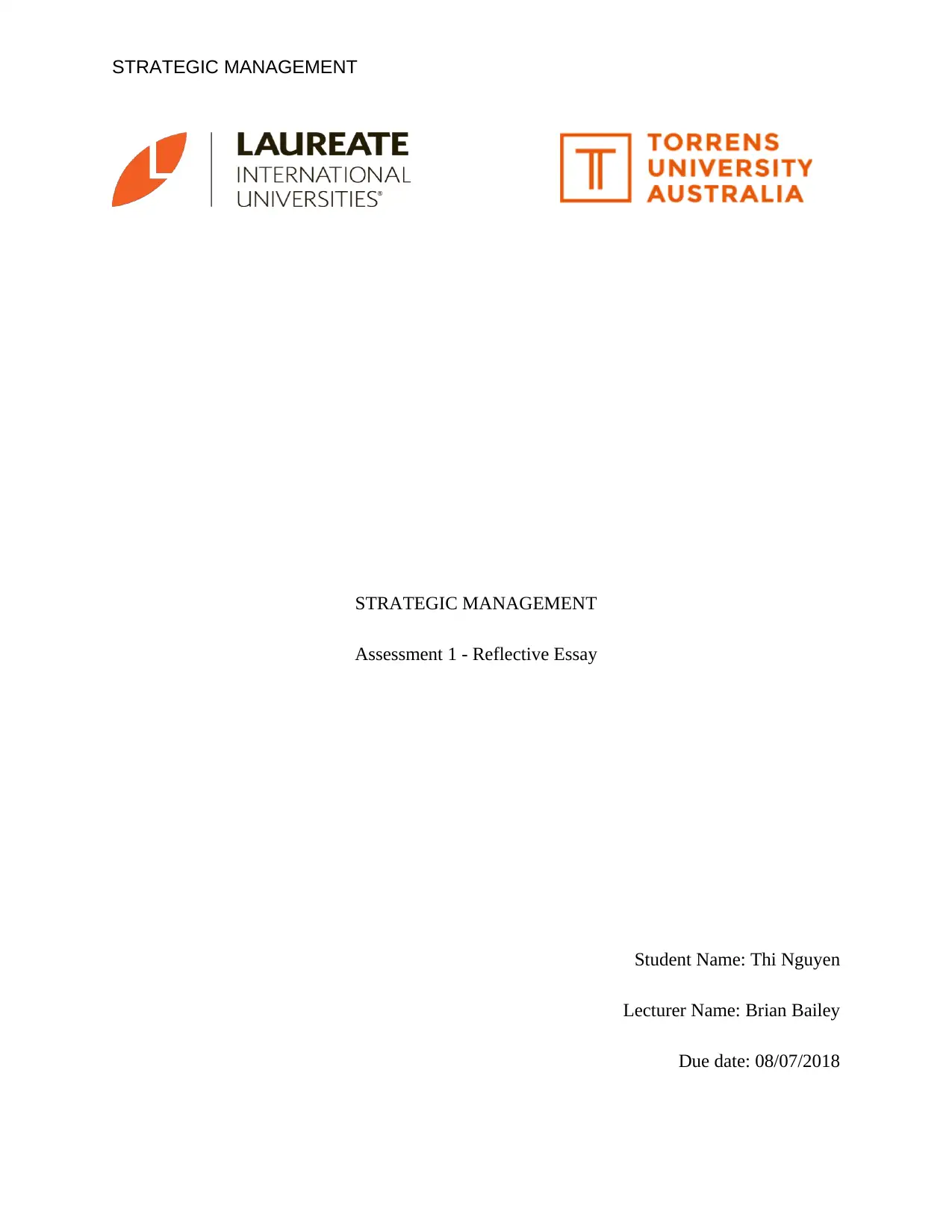
STRATEGIC MANAGEMENT
STRATEGIC MANAGEMENT
Assessment 1 - Reflective Essay
Student Name: Thi Nguyen
Lecturer Name: Brian Bailey
Due date: 08/07/2018
STRATEGIC MANAGEMENT
Assessment 1 - Reflective Essay
Student Name: Thi Nguyen
Lecturer Name: Brian Bailey
Due date: 08/07/2018
Paraphrase This Document
Need a fresh take? Get an instant paraphrase of this document with our AI Paraphraser
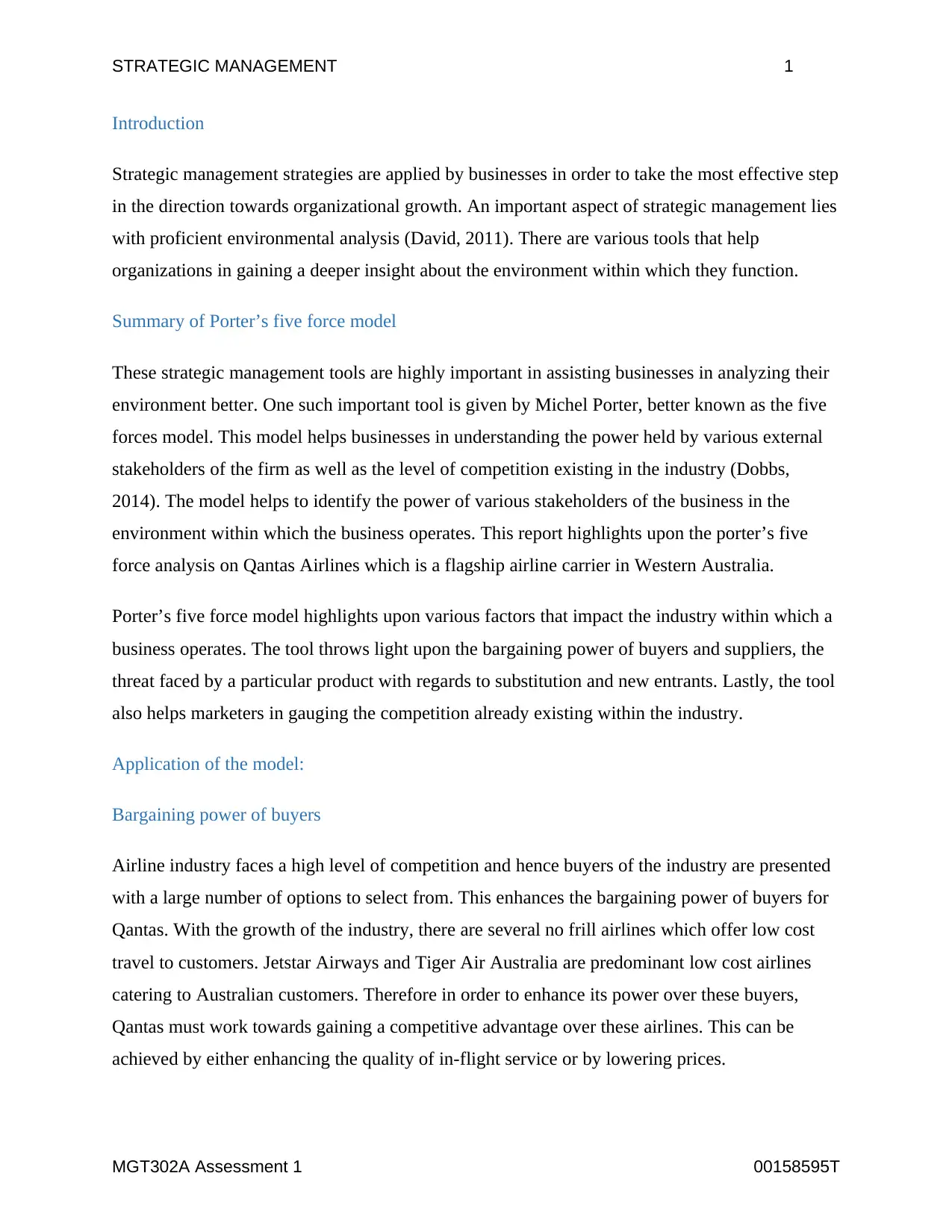
STRATEGIC MANAGEMENT 1
Introduction
Strategic management strategies are applied by businesses in order to take the most effective step
in the direction towards organizational growth. An important aspect of strategic management lies
with proficient environmental analysis (David, 2011). There are various tools that help
organizations in gaining a deeper insight about the environment within which they function.
Summary of Porter’s five force model
These strategic management tools are highly important in assisting businesses in analyzing their
environment better. One such important tool is given by Michel Porter, better known as the five
forces model. This model helps businesses in understanding the power held by various external
stakeholders of the firm as well as the level of competition existing in the industry (Dobbs,
2014). The model helps to identify the power of various stakeholders of the business in the
environment within which the business operates. This report highlights upon the porter’s five
force analysis on Qantas Airlines which is a flagship airline carrier in Western Australia.
Porter’s five force model highlights upon various factors that impact the industry within which a
business operates. The tool throws light upon the bargaining power of buyers and suppliers, the
threat faced by a particular product with regards to substitution and new entrants. Lastly, the tool
also helps marketers in gauging the competition already existing within the industry.
Application of the model:
Bargaining power of buyers
Airline industry faces a high level of competition and hence buyers of the industry are presented
with a large number of options to select from. This enhances the bargaining power of buyers for
Qantas. With the growth of the industry, there are several no frill airlines which offer low cost
travel to customers. Jetstar Airways and Tiger Air Australia are predominant low cost airlines
catering to Australian customers. Therefore in order to enhance its power over these buyers,
Qantas must work towards gaining a competitive advantage over these airlines. This can be
achieved by either enhancing the quality of in-flight service or by lowering prices.
MGT302A Assessment 1 00158595T
Introduction
Strategic management strategies are applied by businesses in order to take the most effective step
in the direction towards organizational growth. An important aspect of strategic management lies
with proficient environmental analysis (David, 2011). There are various tools that help
organizations in gaining a deeper insight about the environment within which they function.
Summary of Porter’s five force model
These strategic management tools are highly important in assisting businesses in analyzing their
environment better. One such important tool is given by Michel Porter, better known as the five
forces model. This model helps businesses in understanding the power held by various external
stakeholders of the firm as well as the level of competition existing in the industry (Dobbs,
2014). The model helps to identify the power of various stakeholders of the business in the
environment within which the business operates. This report highlights upon the porter’s five
force analysis on Qantas Airlines which is a flagship airline carrier in Western Australia.
Porter’s five force model highlights upon various factors that impact the industry within which a
business operates. The tool throws light upon the bargaining power of buyers and suppliers, the
threat faced by a particular product with regards to substitution and new entrants. Lastly, the tool
also helps marketers in gauging the competition already existing within the industry.
Application of the model:
Bargaining power of buyers
Airline industry faces a high level of competition and hence buyers of the industry are presented
with a large number of options to select from. This enhances the bargaining power of buyers for
Qantas. With the growth of the industry, there are several no frill airlines which offer low cost
travel to customers. Jetstar Airways and Tiger Air Australia are predominant low cost airlines
catering to Australian customers. Therefore in order to enhance its power over these buyers,
Qantas must work towards gaining a competitive advantage over these airlines. This can be
achieved by either enhancing the quality of in-flight service or by lowering prices.
MGT302A Assessment 1 00158595T
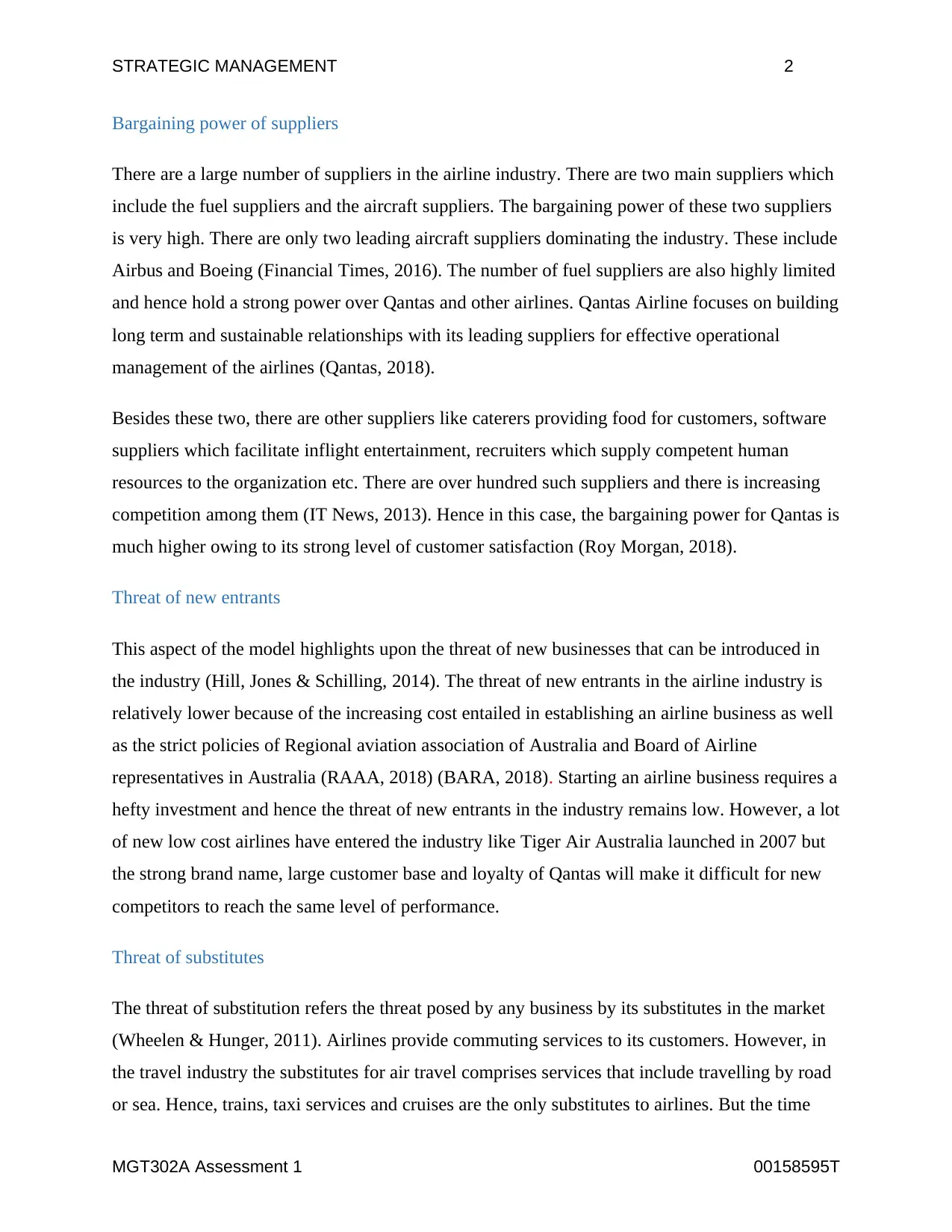
STRATEGIC MANAGEMENT 2
Bargaining power of suppliers
There are a large number of suppliers in the airline industry. There are two main suppliers which
include the fuel suppliers and the aircraft suppliers. The bargaining power of these two suppliers
is very high. There are only two leading aircraft suppliers dominating the industry. These include
Airbus and Boeing (Financial Times, 2016). The number of fuel suppliers are also highly limited
and hence hold a strong power over Qantas and other airlines. Qantas Airline focuses on building
long term and sustainable relationships with its leading suppliers for effective operational
management of the airlines (Qantas, 2018).
Besides these two, there are other suppliers like caterers providing food for customers, software
suppliers which facilitate inflight entertainment, recruiters which supply competent human
resources to the organization etc. There are over hundred such suppliers and there is increasing
competition among them (IT News, 2013). Hence in this case, the bargaining power for Qantas is
much higher owing to its strong level of customer satisfaction (Roy Morgan, 2018).
Threat of new entrants
This aspect of the model highlights upon the threat of new businesses that can be introduced in
the industry (Hill, Jones & Schilling, 2014). The threat of new entrants in the airline industry is
relatively lower because of the increasing cost entailed in establishing an airline business as well
as the strict policies of Regional aviation association of Australia and Board of Airline
representatives in Australia (RAAA, 2018) (BARA, 2018). Starting an airline business requires a
hefty investment and hence the threat of new entrants in the industry remains low. However, a lot
of new low cost airlines have entered the industry like Tiger Air Australia launched in 2007 but
the strong brand name, large customer base and loyalty of Qantas will make it difficult for new
competitors to reach the same level of performance.
Threat of substitutes
The threat of substitution refers the threat posed by any business by its substitutes in the market
(Wheelen & Hunger, 2011). Airlines provide commuting services to its customers. However, in
the travel industry the substitutes for air travel comprises services that include travelling by road
or sea. Hence, trains, taxi services and cruises are the only substitutes to airlines. But the time
MGT302A Assessment 1 00158595T
Bargaining power of suppliers
There are a large number of suppliers in the airline industry. There are two main suppliers which
include the fuel suppliers and the aircraft suppliers. The bargaining power of these two suppliers
is very high. There are only two leading aircraft suppliers dominating the industry. These include
Airbus and Boeing (Financial Times, 2016). The number of fuel suppliers are also highly limited
and hence hold a strong power over Qantas and other airlines. Qantas Airline focuses on building
long term and sustainable relationships with its leading suppliers for effective operational
management of the airlines (Qantas, 2018).
Besides these two, there are other suppliers like caterers providing food for customers, software
suppliers which facilitate inflight entertainment, recruiters which supply competent human
resources to the organization etc. There are over hundred such suppliers and there is increasing
competition among them (IT News, 2013). Hence in this case, the bargaining power for Qantas is
much higher owing to its strong level of customer satisfaction (Roy Morgan, 2018).
Threat of new entrants
This aspect of the model highlights upon the threat of new businesses that can be introduced in
the industry (Hill, Jones & Schilling, 2014). The threat of new entrants in the airline industry is
relatively lower because of the increasing cost entailed in establishing an airline business as well
as the strict policies of Regional aviation association of Australia and Board of Airline
representatives in Australia (RAAA, 2018) (BARA, 2018). Starting an airline business requires a
hefty investment and hence the threat of new entrants in the industry remains low. However, a lot
of new low cost airlines have entered the industry like Tiger Air Australia launched in 2007 but
the strong brand name, large customer base and loyalty of Qantas will make it difficult for new
competitors to reach the same level of performance.
Threat of substitutes
The threat of substitution refers the threat posed by any business by its substitutes in the market
(Wheelen & Hunger, 2011). Airlines provide commuting services to its customers. However, in
the travel industry the substitutes for air travel comprises services that include travelling by road
or sea. Hence, trains, taxi services and cruises are the only substitutes to airlines. But the time
MGT302A Assessment 1 00158595T
⊘ This is a preview!⊘
Do you want full access?
Subscribe today to unlock all pages.

Trusted by 1+ million students worldwide
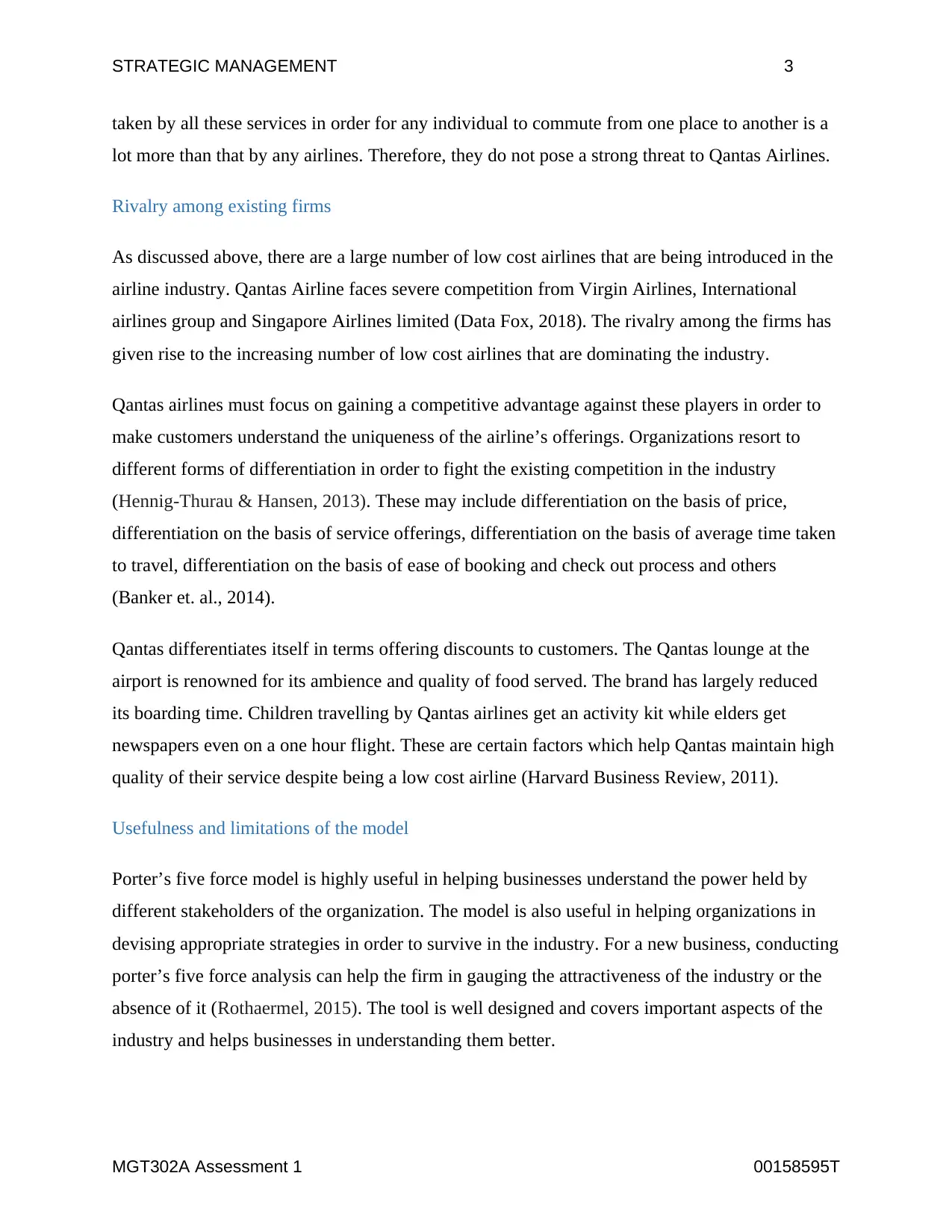
STRATEGIC MANAGEMENT 3
taken by all these services in order for any individual to commute from one place to another is a
lot more than that by any airlines. Therefore, they do not pose a strong threat to Qantas Airlines.
Rivalry among existing firms
As discussed above, there are a large number of low cost airlines that are being introduced in the
airline industry. Qantas Airline faces severe competition from Virgin Airlines, International
airlines group and Singapore Airlines limited (Data Fox, 2018). The rivalry among the firms has
given rise to the increasing number of low cost airlines that are dominating the industry.
Qantas airlines must focus on gaining a competitive advantage against these players in order to
make customers understand the uniqueness of the airline’s offerings. Organizations resort to
different forms of differentiation in order to fight the existing competition in the industry
(Hennig-Thurau & Hansen, 2013). These may include differentiation on the basis of price,
differentiation on the basis of service offerings, differentiation on the basis of average time taken
to travel, differentiation on the basis of ease of booking and check out process and others
(Banker et. al., 2014).
Qantas differentiates itself in terms offering discounts to customers. The Qantas lounge at the
airport is renowned for its ambience and quality of food served. The brand has largely reduced
its boarding time. Children travelling by Qantas airlines get an activity kit while elders get
newspapers even on a one hour flight. These are certain factors which help Qantas maintain high
quality of their service despite being a low cost airline (Harvard Business Review, 2011).
Usefulness and limitations of the model
Porter’s five force model is highly useful in helping businesses understand the power held by
different stakeholders of the organization. The model is also useful in helping organizations in
devising appropriate strategies in order to survive in the industry. For a new business, conducting
porter’s five force analysis can help the firm in gauging the attractiveness of the industry or the
absence of it (Rothaermel, 2015). The tool is well designed and covers important aspects of the
industry and helps businesses in understanding them better.
MGT302A Assessment 1 00158595T
taken by all these services in order for any individual to commute from one place to another is a
lot more than that by any airlines. Therefore, they do not pose a strong threat to Qantas Airlines.
Rivalry among existing firms
As discussed above, there are a large number of low cost airlines that are being introduced in the
airline industry. Qantas Airline faces severe competition from Virgin Airlines, International
airlines group and Singapore Airlines limited (Data Fox, 2018). The rivalry among the firms has
given rise to the increasing number of low cost airlines that are dominating the industry.
Qantas airlines must focus on gaining a competitive advantage against these players in order to
make customers understand the uniqueness of the airline’s offerings. Organizations resort to
different forms of differentiation in order to fight the existing competition in the industry
(Hennig-Thurau & Hansen, 2013). These may include differentiation on the basis of price,
differentiation on the basis of service offerings, differentiation on the basis of average time taken
to travel, differentiation on the basis of ease of booking and check out process and others
(Banker et. al., 2014).
Qantas differentiates itself in terms offering discounts to customers. The Qantas lounge at the
airport is renowned for its ambience and quality of food served. The brand has largely reduced
its boarding time. Children travelling by Qantas airlines get an activity kit while elders get
newspapers even on a one hour flight. These are certain factors which help Qantas maintain high
quality of their service despite being a low cost airline (Harvard Business Review, 2011).
Usefulness and limitations of the model
Porter’s five force model is highly useful in helping businesses understand the power held by
different stakeholders of the organization. The model is also useful in helping organizations in
devising appropriate strategies in order to survive in the industry. For a new business, conducting
porter’s five force analysis can help the firm in gauging the attractiveness of the industry or the
absence of it (Rothaermel, 2015). The tool is well designed and covers important aspects of the
industry and helps businesses in understanding them better.
MGT302A Assessment 1 00158595T
Paraphrase This Document
Need a fresh take? Get an instant paraphrase of this document with our AI Paraphraser
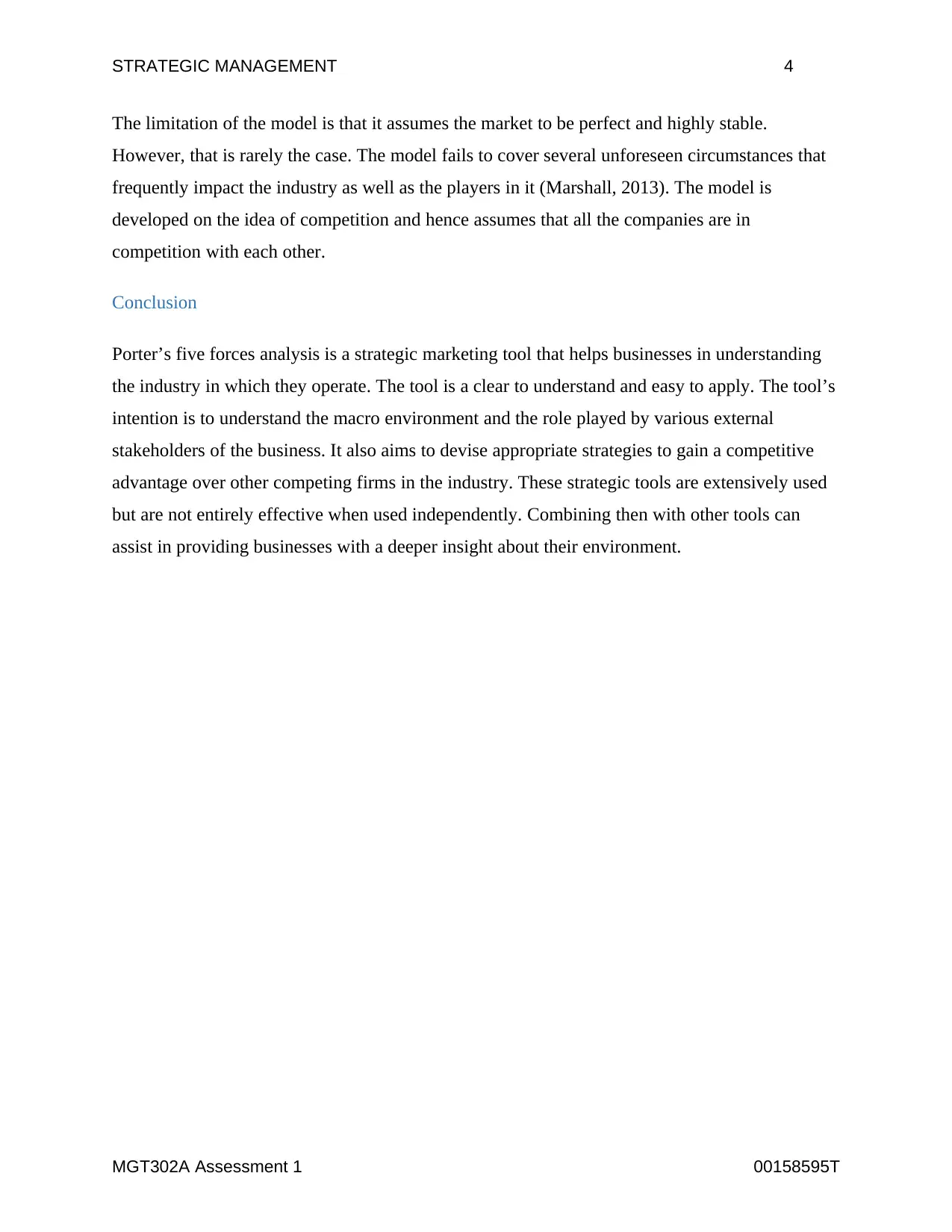
STRATEGIC MANAGEMENT 4
The limitation of the model is that it assumes the market to be perfect and highly stable.
However, that is rarely the case. The model fails to cover several unforeseen circumstances that
frequently impact the industry as well as the players in it (Marshall, 2013). The model is
developed on the idea of competition and hence assumes that all the companies are in
competition with each other.
Conclusion
Porter’s five forces analysis is a strategic marketing tool that helps businesses in understanding
the industry in which they operate. The tool is a clear to understand and easy to apply. The tool’s
intention is to understand the macro environment and the role played by various external
stakeholders of the business. It also aims to devise appropriate strategies to gain a competitive
advantage over other competing firms in the industry. These strategic tools are extensively used
but are not entirely effective when used independently. Combining then with other tools can
assist in providing businesses with a deeper insight about their environment.
MGT302A Assessment 1 00158595T
The limitation of the model is that it assumes the market to be perfect and highly stable.
However, that is rarely the case. The model fails to cover several unforeseen circumstances that
frequently impact the industry as well as the players in it (Marshall, 2013). The model is
developed on the idea of competition and hence assumes that all the companies are in
competition with each other.
Conclusion
Porter’s five forces analysis is a strategic marketing tool that helps businesses in understanding
the industry in which they operate. The tool is a clear to understand and easy to apply. The tool’s
intention is to understand the macro environment and the role played by various external
stakeholders of the business. It also aims to devise appropriate strategies to gain a competitive
advantage over other competing firms in the industry. These strategic tools are extensively used
but are not entirely effective when used independently. Combining then with other tools can
assist in providing businesses with a deeper insight about their environment.
MGT302A Assessment 1 00158595T
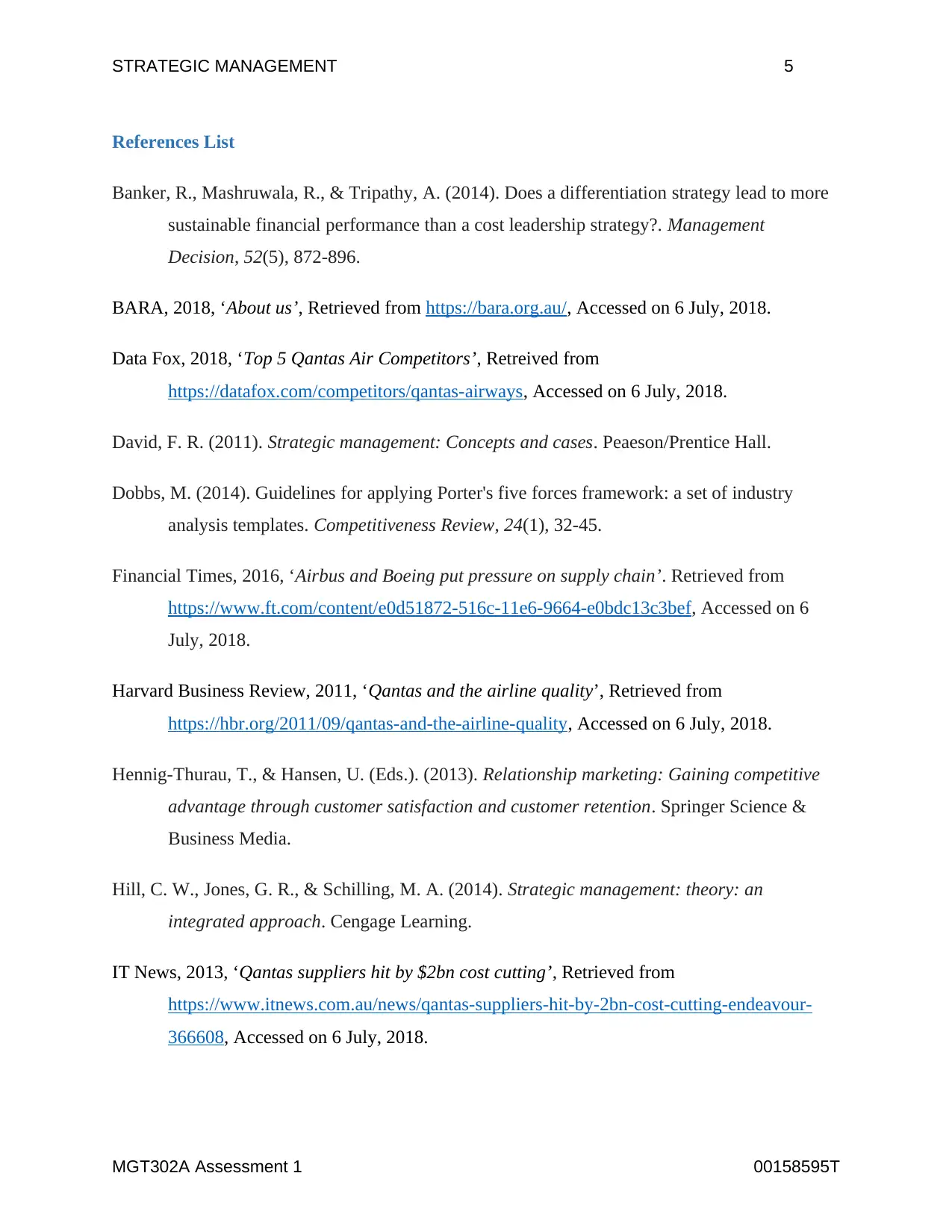
STRATEGIC MANAGEMENT 5
References List
Banker, R., Mashruwala, R., & Tripathy, A. (2014). Does a differentiation strategy lead to more
sustainable financial performance than a cost leadership strategy?. Management
Decision, 52(5), 872-896.
BARA, 2018, ‘About us’, Retrieved from https://bara.org.au/, Accessed on 6 July, 2018.
Data Fox, 2018, ‘Top 5 Qantas Air Competitors’, Retreived from
https://datafox.com/competitors/qantas-airways, Accessed on 6 July, 2018.
David, F. R. (2011). Strategic management: Concepts and cases. Peaeson/Prentice Hall.
Dobbs, M. (2014). Guidelines for applying Porter's five forces framework: a set of industry
analysis templates. Competitiveness Review, 24(1), 32-45.
Financial Times, 2016, ‘Airbus and Boeing put pressure on supply chain’. Retrieved from
https://www.ft.com/content/e0d51872-516c-11e6-9664-e0bdc13c3bef, Accessed on 6
July, 2018.
Harvard Business Review, 2011, ‘Qantas and the airline quality’, Retrieved from
https://hbr.org/2011/09/qantas-and-the-airline-quality, Accessed on 6 July, 2018.
Hennig-Thurau, T., & Hansen, U. (Eds.). (2013). Relationship marketing: Gaining competitive
advantage through customer satisfaction and customer retention. Springer Science &
Business Media.
Hill, C. W., Jones, G. R., & Schilling, M. A. (2014). Strategic management: theory: an
integrated approach. Cengage Learning.
IT News, 2013, ‘Qantas suppliers hit by $2bn cost cutting’, Retrieved from
https://www.itnews.com.au/news/qantas-suppliers-hit-by-2bn-cost-cutting-endeavour-
366608, Accessed on 6 July, 2018.
MGT302A Assessment 1 00158595T
References List
Banker, R., Mashruwala, R., & Tripathy, A. (2014). Does a differentiation strategy lead to more
sustainable financial performance than a cost leadership strategy?. Management
Decision, 52(5), 872-896.
BARA, 2018, ‘About us’, Retrieved from https://bara.org.au/, Accessed on 6 July, 2018.
Data Fox, 2018, ‘Top 5 Qantas Air Competitors’, Retreived from
https://datafox.com/competitors/qantas-airways, Accessed on 6 July, 2018.
David, F. R. (2011). Strategic management: Concepts and cases. Peaeson/Prentice Hall.
Dobbs, M. (2014). Guidelines for applying Porter's five forces framework: a set of industry
analysis templates. Competitiveness Review, 24(1), 32-45.
Financial Times, 2016, ‘Airbus and Boeing put pressure on supply chain’. Retrieved from
https://www.ft.com/content/e0d51872-516c-11e6-9664-e0bdc13c3bef, Accessed on 6
July, 2018.
Harvard Business Review, 2011, ‘Qantas and the airline quality’, Retrieved from
https://hbr.org/2011/09/qantas-and-the-airline-quality, Accessed on 6 July, 2018.
Hennig-Thurau, T., & Hansen, U. (Eds.). (2013). Relationship marketing: Gaining competitive
advantage through customer satisfaction and customer retention. Springer Science &
Business Media.
Hill, C. W., Jones, G. R., & Schilling, M. A. (2014). Strategic management: theory: an
integrated approach. Cengage Learning.
IT News, 2013, ‘Qantas suppliers hit by $2bn cost cutting’, Retrieved from
https://www.itnews.com.au/news/qantas-suppliers-hit-by-2bn-cost-cutting-endeavour-
366608, Accessed on 6 July, 2018.
MGT302A Assessment 1 00158595T
⊘ This is a preview!⊘
Do you want full access?
Subscribe today to unlock all pages.

Trusted by 1+ million students worldwide
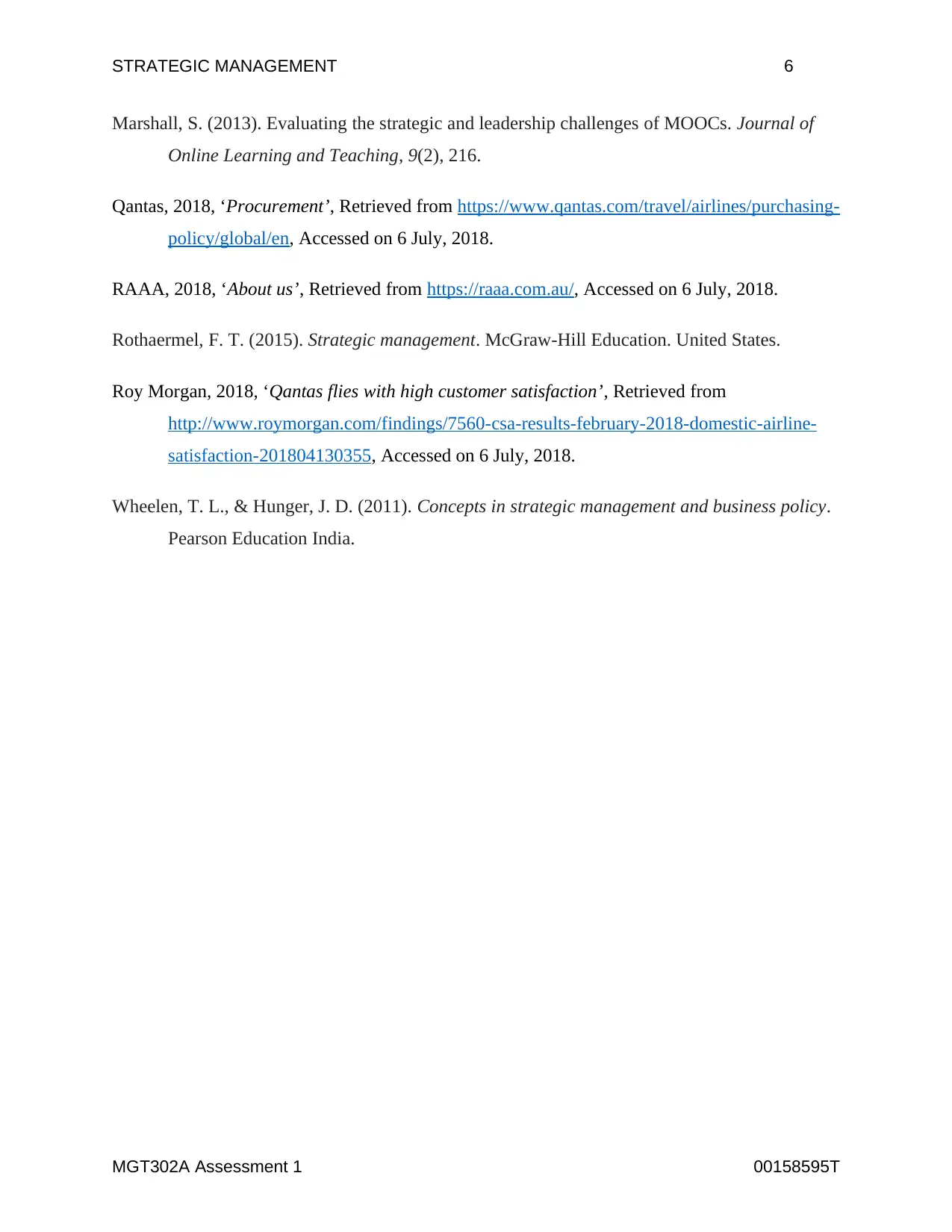
STRATEGIC MANAGEMENT 6
Marshall, S. (2013). Evaluating the strategic and leadership challenges of MOOCs. Journal of
Online Learning and Teaching, 9(2), 216.
Qantas, 2018, ‘Procurement’, Retrieved from https://www.qantas.com/travel/airlines/purchasing-
policy/global/en, Accessed on 6 July, 2018.
RAAA, 2018, ‘About us’, Retrieved from https://raaa.com.au/, Accessed on 6 July, 2018.
Rothaermel, F. T. (2015). Strategic management. McGraw-Hill Education. United States.
Roy Morgan, 2018, ‘Qantas flies with high customer satisfaction’, Retrieved from
http://www.roymorgan.com/findings/7560-csa-results-february-2018-domestic-airline-
satisfaction-201804130355, Accessed on 6 July, 2018.
Wheelen, T. L., & Hunger, J. D. (2011). Concepts in strategic management and business policy.
Pearson Education India.
MGT302A Assessment 1 00158595T
Marshall, S. (2013). Evaluating the strategic and leadership challenges of MOOCs. Journal of
Online Learning and Teaching, 9(2), 216.
Qantas, 2018, ‘Procurement’, Retrieved from https://www.qantas.com/travel/airlines/purchasing-
policy/global/en, Accessed on 6 July, 2018.
RAAA, 2018, ‘About us’, Retrieved from https://raaa.com.au/, Accessed on 6 July, 2018.
Rothaermel, F. T. (2015). Strategic management. McGraw-Hill Education. United States.
Roy Morgan, 2018, ‘Qantas flies with high customer satisfaction’, Retrieved from
http://www.roymorgan.com/findings/7560-csa-results-february-2018-domestic-airline-
satisfaction-201804130355, Accessed on 6 July, 2018.
Wheelen, T. L., & Hunger, J. D. (2011). Concepts in strategic management and business policy.
Pearson Education India.
MGT302A Assessment 1 00158595T
1 out of 7
Related Documents
Your All-in-One AI-Powered Toolkit for Academic Success.
+13062052269
info@desklib.com
Available 24*7 on WhatsApp / Email
![[object Object]](/_next/static/media/star-bottom.7253800d.svg)
Unlock your academic potential
Copyright © 2020–2025 A2Z Services. All Rights Reserved. Developed and managed by ZUCOL.





